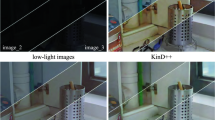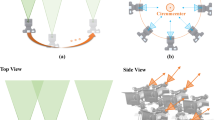Abstract
No-reference image quality assessment (NR-IQA) metrics play an important role in real-world multimedia applications. Accordingly, many NR-IQA metrics have been proposed in the literature. Most of these proposed metrics predict the visual quality only of images distorted with a single distortion, whereas in the real-world, digital images undergo various steps that contaminate them with multiple distortions before reaching consumers. However, only a few NR-IQA metrics have been proposed for multiple distortions. In this paper, we propose an NR-IQA metric for images distorted with blur and noise, which are added during the image acquisition and transmission process. In the proposed metric, perceived blur and noise scores are estimated separately. These scores are then mapped to the final quality score considering the perceived degree of each type of distortion, the nonlinear functions of the distortions, and the joint effects of the distortions. Weights for each mapping component are learned with subjective data input. Performance comparison of the proposed metric on the blur-noise image dataset of the LIVE multiply distorted (LIVEMD) image quality database confirm that the proposed metric is more effective than the state-of-the-art full-reference and NR IQA metrics.












Similar content being viewed by others
References
Chandler DM, Lim KH, Hemami SS (2006) Effects of spatial correlations and global precedence on the visual fidelity of distorted images. In Electronic Imaging International Society for Optics and Photonics 60570F-60570F. doi:10.1117/12.655442
Ferzli R, Karam L (2009) A no-reference objective image sharpness metric based on the notion of just noticeable blur (JNB). IEEE Trans Image Process 18(4):717–728. doi:10.1109/tip.2008.2011760
Gonzalez RC, Woods RE (2008) Digital Image Processing, 3rd edn. Pearson Prentice-Hall, Upper Saddle River
Granrath DJ (1981) The role of human visual models in image processing. Proc IEEE 69(5):552–561. doi:10.1109/proc.1981.12024
Gu K, Zhai G, Yang X, Zhang W (2014) Hybrid no-reference quality metric for singly and multiply distorted images. IEEE Trans Broadcast 60(3):555–567. doi:10.1109/tbc.2014.2344471
Hassen R, Wang Z, Salama M (2013) Image Sharpness Assessment Based on Local Phase Coherence. IEEE Trans Image Process 22(7):2798–2810. doi:10.1109/tip.2013.2251643
Immerkaer J (1996) Fast noise variance estimation. Comput Vis Image Underst 64(2):300–302. doi:10.1006/cviu.1996.0060
Jayaraman D, Mittal A, Moorthy AK, Bovik AC (2012) Objective image quality assessment of multiply distorted images. Conference Record of the Forty Sixth Asilomar Conference on Signals, Systems and Computers (ASILOMAR) IEEE, pp 1693–1697. doi:10.1109/aiccsa.2015.7507114
Larson EC, Chandler DM (2010) Most apparent distortion: full-reference image quality assessment and the role of strategy. Journal of Electronic Imaging 19(1):011006–011006. doi:10.1117/1.3267105
Li Q, Lin W, Fang Y (2016) No-Reference Quality Assessment for Multiply-Distorted Images in Gradient Domain. IEEE Signal Processing Letters 23(4):541–545. doi:10.1109/lsp.2016.2537321
Liu A, Lin W, Narwaria M (2012) Image quality assessment based on gradient similarity. IEEE Trans Image Process 21(4):1500–1512. doi:10.1109/tip.2011.2175935
Liu X, Tanaka M, Okutomi M (2013) Single-image noise level estimation for blind denoising. IEEE Trans Image Process 22(12):5226–5237. doi:10.1109/tip.2013.2283400
Lu Y, Xie F, Liu T, Jiang Z, Tao D (2015) No reference quality assessment for multiply-distorted images based on an improved bag-of-words model. IEEE Signal Processing Letters 22(10):1811–1815. doi:10.1109/lsp.2015.2436908
Ma L, Li S, Zhang F, Ngan KN (2011) Reduced-reference image quality assessment using reorganized DCT-based image representation. IEEE Transactions on Multimedia 13(4):824–829. doi:10.1109/tmm.2011.2109701
Marziliano P, Dufaux F, Winkler S, Ebrahimi T (2004) Perceptual blur and ringing metrics: Applications to Jpeg 2000. Signal Process Image Commun 19(2):163–172. doi:10.1016/j.image.2003.08.003
Mittal A, Moorthy AK, Bovik AC (2012) No reference Image Quality Assessment in the Spatial Domain. IEEE Trans Image Process 21(12):4695–4708. doi:10.1109/tip.2012.2214050
Mittal A, Soundararajan R, Bovik AC (2013) Making a Completely Blind Image Quality Analyzer. IEEE Signal Processing Letters 20(3):209–212. doi:10.1109/lsp.2012.2227726
Moorthy AK, Bovik AC (2010) A Two step Framework for Constructing Blind Image Quality Indices. IEEE Signal Processing Letters 17(5):513–516. doi:10.1109/lsp.2010.2043888
Narvekar N, Karam L (2011) A No-Reference Image Blur Metric Based on the Cumulative Probability of Blur Detection (CPBD). IEEE Trans Image Process 20(9):2678–2683. doi:10.1109/tip.2011.2131660
Ponomarenko N, Jin L, Leremeiev O, Lukin V, Egiazarian K, Astola J, Vozel B, Chehdi K, Carli M, Battisti F, CCJ K (2015) Image database TID2013: Peculiarities, results and perspectives. Signal Process Image Commun 30:57–77. doi:10.1016/j.image.2014.10.009
Sheikh HR, Bovik AC (2006) Image information and visual quality. IEEE Trans Image Process 15(2):430–444. doi:10.1109/tip.2005.859378
Sheikh HR, Sabir MF, Bovik AC (2006) A statistical evaluation of recent full reference image quality assessment algorithms. IEEE Trans Image Process 15(11):3440–3451. doi:10.1109/tip.2006.881959
Sheikh HR, Wang Z, Cormack L, Bovik AC (2005) LIVE image quality assessment database release 2. Available: http://live.ece.utexas.edu/research/quality [online]
Sodhani P, Bordia A, Karthik K (2015) Blind Content Independent Noise Estimation for Multimedia Applications. Procedia Computer Science 54:549–557. doi:10.1016/j.procs.2015.06.063
Wang Z, Bovik AC, Sheikh HR, Simoncelli EP (2004) Image quality assessment from error visibility to structural similarity. IEEE Trans Image Process 13(4):600–612. doi:10.1109/TIP.2003.819861
Wang Z, Li Q (2011) Information content weighting for perceptual image quality assessment. IEEE Trans Image Process 20(5):1185–1198. doi:10.1109/tip.2010.2092435
Wang Z, Simoncelli EP, Bovik AC (2003) Multiscale structural similarity for image quality assessment. The Thrity-Seventh Asilomar Conference on Signals, Systems & Computers 2:1398–1402. doi:10.1109/acssc.2003.1292216
Xue W, Zhang L, Mou X (2013) Learning without human scores for blind image quality assessment. In Proceedings of the IEEE Conference on Computer Vision and Pattern Recognition, pp 995–1002. doi:10.1109/cvpr.2013.133
Xue W, Zhang L, Mou X, Bovik AC (2014) Gradient magnitude similarity deviation: A highly efficient perceptual image quality index. IEEE Trans Image Process 23(2):684–695. doi:10.1109/tip.2013.2293423
Zhang L, Li H (2012) SR-SIM: A fast and high performance IQA index based on spectral residual. 19th IEEE International Conference on Image Processing, pp 1473–1476. doi:10.1109/icip.2012.6467149
Zhang L, Shen Y, Li H (2014) VSI: A visual saliency-induced index for perceptual image quality assessment. IEEE Trans Image Process 23(10):4270–4281. doi:10.1109/tip.2014.2346028
Zhang L, Zhang L, & Mou X. (2010, September) RFSIM: a feature based image quality assessment metric using Riesz transforms. 17th IEEE International Conference on Image Processing, pp 321–324. doi:10.1109/icip.2010.5649275
Zhang L, Zhang L, Mou X, Zhang D (2011) FSIM: A feature similarity index for image quality assessment. IEEE Trans Image Process 20(8):2378–2386. doi:10.1109/tip.2011.2109730
Zhu X, Milanfar P (2010) Automatic parameter selection for denoising algorithms using a no-reference measure of image content. IEEE Trans Image Process 19(12):3116–3132. doi:10.1109/tip.2010.2052820
Author information
Authors and Affiliations
Corresponding author
Rights and permissions
About this article
Cite this article
Lamb, A.B., Khambete, M. No-reference perceived image quality measurement for multiple distortions. Multimed Tools Appl 77, 8653–8675 (2018). https://doi.org/10.1007/s11042-017-4761-3
Received:
Revised:
Accepted:
Published:
Issue Date:
DOI: https://doi.org/10.1007/s11042-017-4761-3




